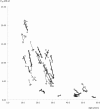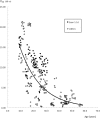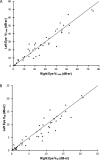Characterization of Visual Function, Interocular Variability and Progression Using Static Perimetry-Derived Metrics in RPGR-Associated Retinopathy
- PMID: 29847648
- PMCID: PMC5947973
- DOI: 10.1167/iovs.17-23739
Characterization of Visual Function, Interocular Variability and Progression Using Static Perimetry-Derived Metrics in RPGR-Associated Retinopathy
Abstract
Purpose: To characterize bilateral visual function, interocular variability and progression by using static perimetry-derived volumetric and pointwise metrics in subjects with retinitis pigmentosa associated with mutations in the retinitis pigmentosa GTPase regulator (RPGR) gene.
Methods: This was a prospective longitudinal observational study of 47 genetically confirmed subjects. Visual function was assessed with ETDRS and Pelli-Robson charts; and Octopus 900 static perimetry using a customized, radially oriented 185-point grid. Three-dimensional hill-of-vision topographic models were produced and interrogated with the Visual Field Modeling and Analysis software to obtain three volumetric metrics: VTotal, V30, and V5. These were analyzed together with Octopus mean sensitivity values. Interocular differences were assessed with the Bland-Altman method. Metric-specific exponential decline rates were calculated.
Results: Baseline symmetry was demonstrated by relative interocular difference values of 1% for VTotal and 8% with V30. Degree of symmetry varied between subjects and was quantified with the subject percentage interocular difference (SPID). SPID was 16% for VTotal and 17% for V30. Interocular symmetry in progression was greatest when quantified by VTotal and V30, with 73% and 64% of subjects possessing interocular rate differences smaller in magnitude than respective annual progression rates. Functional decline was evident with increasing age. An overall annual exponential decline of 6% was evident with both VTotal and V30.
Conclusions: In general, good interocular symmetry exists; however, there was both variation between subjects and with the use of various metrics. Our findings will guide patient selection and design of RPGR treatment trials, and provide clinicians with specific prognostic information to offer patients affected by this condition.
Figures







References
-
- Hartong DT, Berson EL, Dryja TP. . Retinitis pigmentosa. . 2006; 368: 1795– 1809. - PubMed
-
- Haim M. . Epidemiology of retinitis pigmentosa in Denmark. . 2002; 233: 1– 34. - PubMed
-
- You QS, Xu L, Wang YX,et al. . Prevalence of retinitis pigmentosa in North China: the Beijing Eye Public Health Care Project. . 2013; 91: e499– e500. - PubMed
Publication types
MeSH terms
Substances
Grants and funding
LinkOut - more resources
Full Text Sources
Other Literature Sources
Medical

